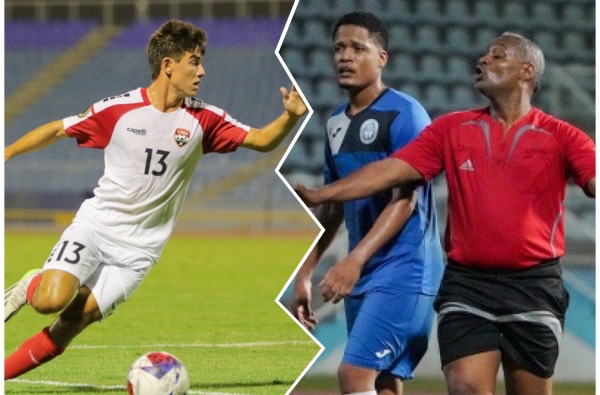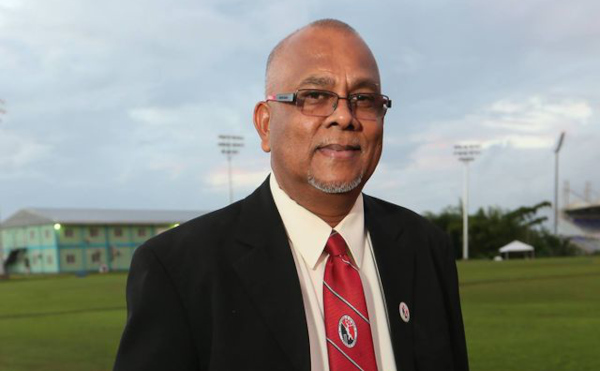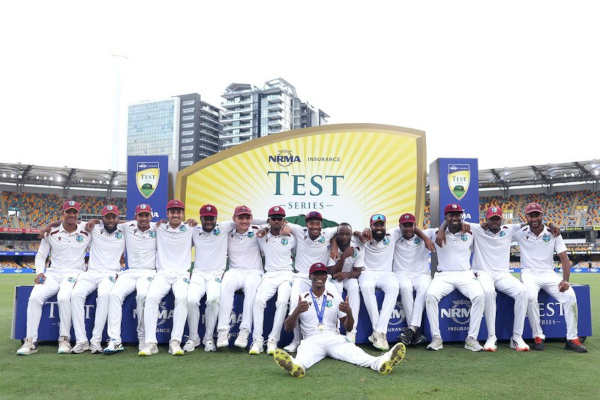“[…] The Guyana Cricket Board in conjunction with the Government of Guyana has had the foresight to acquire the services of former West Indies great Curtly Ambrose to conduct a fast bowling clinic, while, in T&T, the TTCB has launched a T10 cricket festival.
“[…] When a regional board doesn’t understand that players who are properly developed through playing the longer format will adjust and become better players in any other format, then you know we’re going to continue going nowhere very fast…”
Former Trinidad and Tobago and Queen’s Park Cricket Club allrounder Andre Lawrence considers the dearth of sound batsmen in the West Indies, Phil Simmons’ responsibility as head coach, and the rise of wicketkeeper/batsman Joshua Da Silva:

As the region gets set to host England in a three-match Test Series from 8 March, WI head coach Phil Simmons this week is quoted as saying that: “It (batting) does need urgent attention because it has just lost us the last two games. I think you bowl India out for 230-odd, 260-odd and you’d expect to chase it.”
Our batting requiring urgent attention can in no way be classed as headline news. But what is the genesis of this dire issue, one in which our batsmen could not even bat out the allotted 50 overs in the last nine ODIs?
The developmental needs of our regional players are many, so what do our regional boards do to address this? Over the last few years we’ve seen the closure of the WI Cricket Academy located in Barbados and a decline in A or B Team developmental tours. However, let’s take a look at what has been happening in more recent times.
The Guyana Cricket Board in conjunction with the Government of Guyana has had the foresight to acquire the services of former West Indies great Curtly Ambrose to conduct a fast bowling clinic, while, in T&T, the TTCB has launched a T10 cricket festival.

(Copyright Newsday)
All credit to Guyana’s thought processes and developmental efforts. But sorry, TTCB, what an abject waste of hard-to-get sponsorship money, time and energy! Again, we can see where the focus is NOT. Certainly NOT on developing batsmen and their proper technique, exactly what Phil Simmons is crying out for.
Cricket is a sport quite different from many. There’s no shortcut to becoming a good player. To perfect the art of batting and bowling requires many long hours and regular practice.
When a regional board doesn’t understand that players who are properly developed through playing the longer format will adjust and become better players in any other format, then you know we’re going to continue going nowhere very fast.
More hustle dollars for the players, (as opposed to spending quality time truly learning and understanding their game), more instant slog fests, more wine and jam for a handful of spectators, that is all that will be achieved. Nothing more.

(Courtesy Sean Morrison/Wired868)
Where’s the evidence of the longer format creating better players in the modern era? You don’t have to look very far: Kieron Pollard, Chris Gayle, Andre Russell, Sunil Narine, Lendl Simmons, Dwayne Bravo—all IPL/franchise superstars, all brought up playing club and first-class cricket which developed their cricketing skills, enabling them to successfully transition to becoming some of the most sought after players in franchise cricket history.
It also enabled the WI to benefit with two consecutive T20 World Cup titles in 2012 and 2016.
But everyone gets excited over the shorter format. England have paid a heavy price for shifting focus. Only two years ago, they celebrated several milestones. The county cricket format propelled them to the number one Test ranking and they are currently ranked number one by the ICC in T20s as well as finally attaining a 50-over World Cup title in 2019.
Life couldn’t be better…
So someone at the ECB decided on a novel idea. Born was The Hundred event during the last English summer. The results of this for English cricket have been swift and catastrophic.

During this period of implementation and change of focus, England have plummeted to fourth in Tests (a mere two points ahead of South Africa and eight ahead of Pakistan), lost 10 of their last 14 Test matches, the most recent Ashes series 4-0 and a five-match T20 series 2-3 to the WI.
Straightaway after the dismal Ashes series, they fired the director of cricket, head coach and assistant coach.
But even though our batsmen cannot concentrate for lengthy periods and our bowlers constantly stray off a much-needed consistent line and length, here at home, we launch a T10 event. At the same time, club cricket (the pathway to developing young cricketers) in T&T is an absolute disaster.
The one entity that continues to attempt the right thing is the Queen’s Park Cricket Club. So much so that practically all the top local players have one simple formula to advance their careers: leave whatever club they are currently with and join the QPCC.

(Copyright AFP / Lakruwan Wanniarachchi)
There’s been no concerted effort to assist all clubs to develop proper structure, youth development training programmes, cricket management and improved facilities such as proper nets, etc. The order of the day is take the easy and popular road aka the franchise event.
As I write, I look around the region at the 4-day first-class competition. At the end of Round One, there was only one century maker and it is clear to see that batsmen lack the temperament and technique required to advance their game to the point where, elevated to international status, they have a better-than-even chance of competing well at that level.
(Editor’s Note: there were three centurions by the end of Round Two.)
Our first-class event is churning out underdeveloped cricketers.
Those who think that the WI coaches can effect significant change with our current players are dreaming. The stark reality is that international coaches get to spend very little time with players prior to touring.

(Copyright AFP)
The true effectiveness of an international coach demands that they create an environment where players feel enthusiastic about training, learning and playing to the best of their ability, match strategy and team management.
Justin Langer, one of the world’s most respected and successful international coaches, has just had cause to controversially resign, as Cricket Australia, backed by several senior players, felt that this is where he fell short—even if the team is winning.
What can be done to gain some short-term benefits and results? The players themselves must play a significant role and find a way to dedicate an enormous amount of personal time to working on their game.
Right in front of us, there is one shining example: WI wicketkeeper/batsman Joshua Da Silva.
Seemingly out of nowhere, this young and improving player, (currently averaging around 40 with the bat this first-class season), used a simple formula.

(Copyright Daniel Prentice/ Wired868)
While players were spending lockdown time relaxing and gaining weight, Da Silva developed a personal training regime that saw him on early mornings running along the highway in Diego Martin where he lives and shadow netting in his yard as nets weren’t readily available. He also sought overseas assistance on dieting and fitness training techniques and technical advice from his local coaches.
It has been the making of a player who was unexpectedly catapulted into international cricket when Shane Dowrich, the then WI wicketkeeper/batsman, pulled out of the tour in New Zealand citing personal reasons. Against arguably the best bowling attack in the world, Da Silva announced his arrival on the international stage with an unbeaten half-century.
The Da Silva example shows us what is possible with a determined effort, planning and straight out hard work. So no one can convince me that the road to success in WI cricket is impassible.
What is required is the correct focus from our cricket hierarchy, planning, and good, old-fashioned hard work from the players, not more and more instant cricket.

(via CWI Media)
Five years ago, I toured New Zealand as head coach of an U-17 team of Caribbean players. I met several national youth coaches, directors of cricket and club presidents there and it was fantastic to learn and understand their cricket culture.
From age 11, teams play time cricket over two afternoons after school, allowing them to learn to bat without the restriction of overs, and learning from a young age when to declare and allow the other team to chase, etc.
No children are allowed to play T20 cricket until they get to age 17 or when they start playing club cricket, whichever comes first. By the time this happens, they have already significantly developed their batting/bowling technique and their temperament for playing an innings effectively.
All that’s left is to adjust to the different formats of the game.

(Copyright Stuff.co.nz)
Five years later, they are hugely competitive in all formats and the world has seen them become World Test Champions.
I rest my case.
|
Wired868 has provided readers with solid, independent journalism since 2012. If you appreciate our work, please contribute to our efforts. Support Independent Journalism |
 Wired868 Wired868 for smart sport news and opinion
Wired868 Wired868 for smart sport news and opinion










Amazing perspectives brought forward. This article basically sums up the state of Trinidad and Tobago and West Indies cricket. We are in a crisis, especially Trinidad and Tobago cricket. There is no proactive leadership at this moment, and the board seems confused about and unaware of the long-term path forward and are blinded to the solutions.
The outcome of the just concluded T20 (India) is a clear case in point. India’s batters were skilled enough to manipulate the field set to make runs even when the bowling was good/tight. Our batsmen when faced with a similar scenario generally found the fielders.
A lot of work has to be done to improve the cricketers we are producing because our players’ deficiencies are being cruelly exposed. Their confidence levels are taking a serious beating. You don’t have to look far. Just look at Darren Bravo, once considered to be one to follow in the footsteps of no lesser great than B.C. Lara.
Where has he fallen to now?